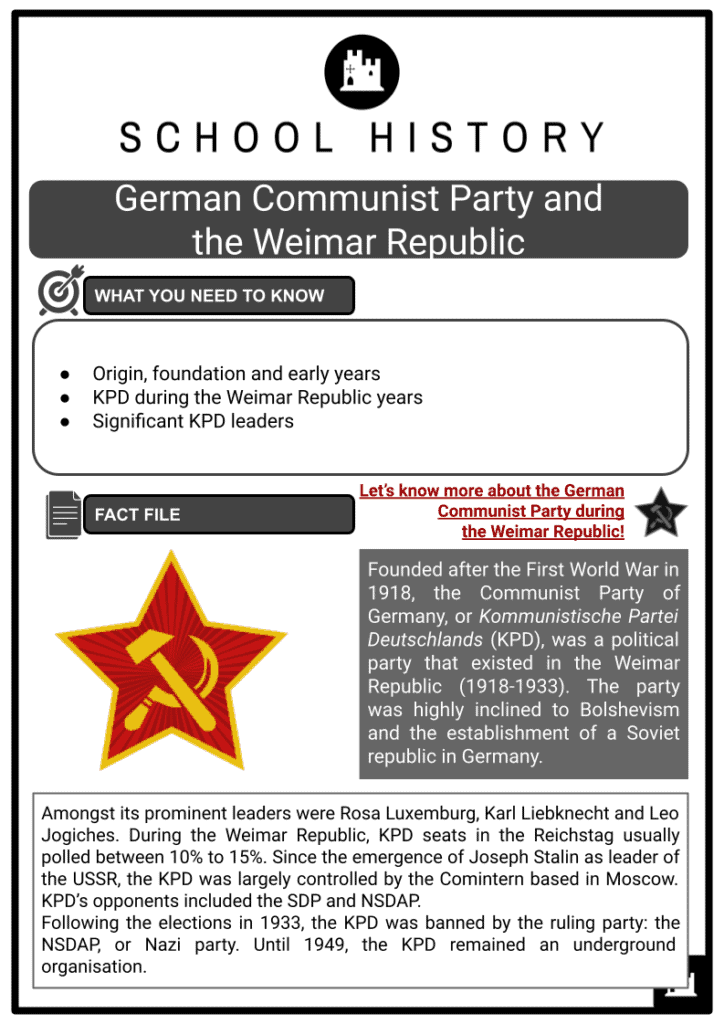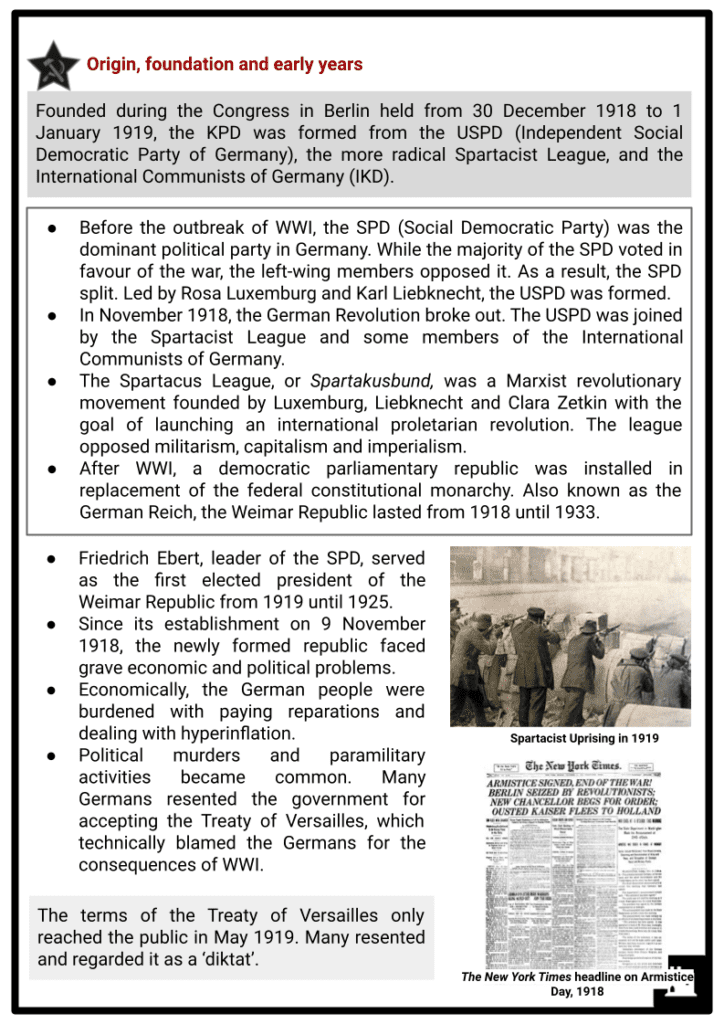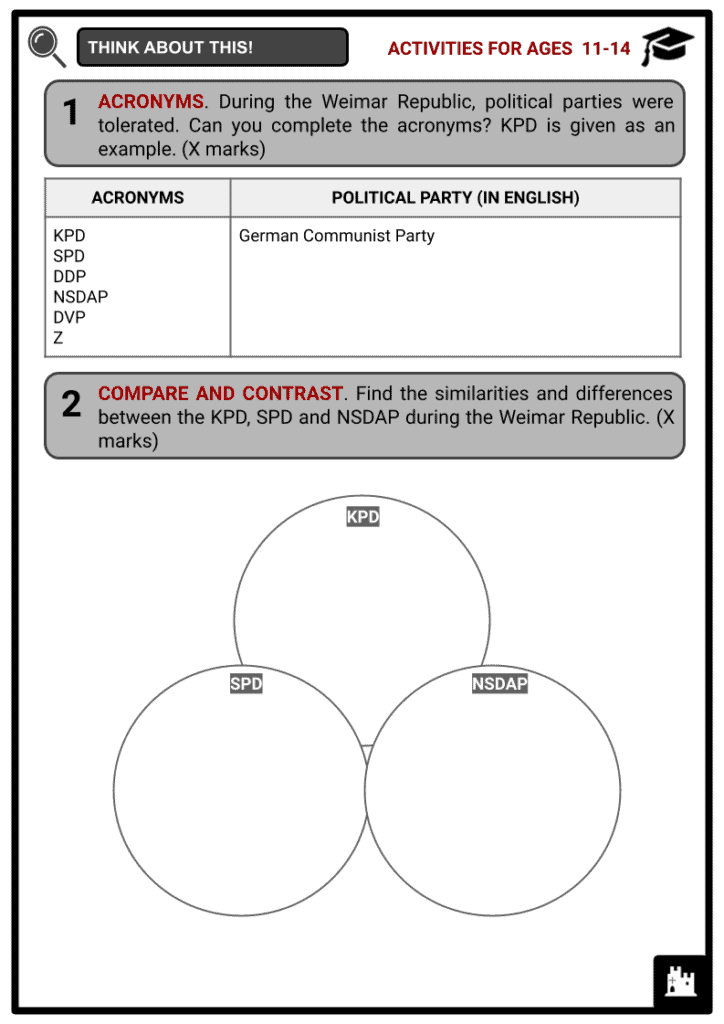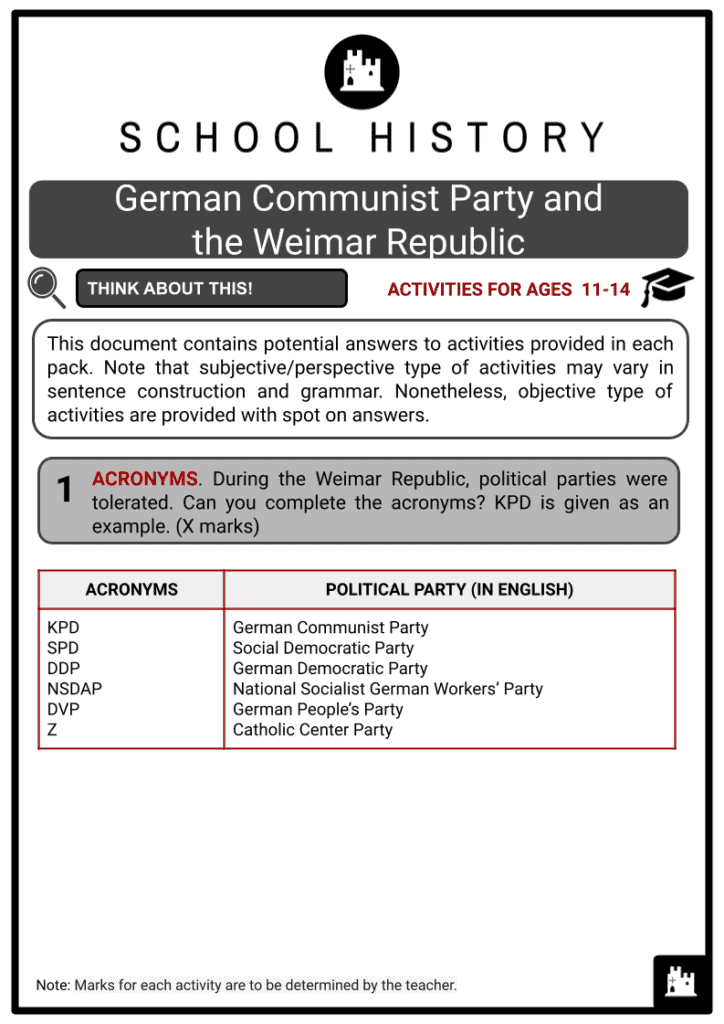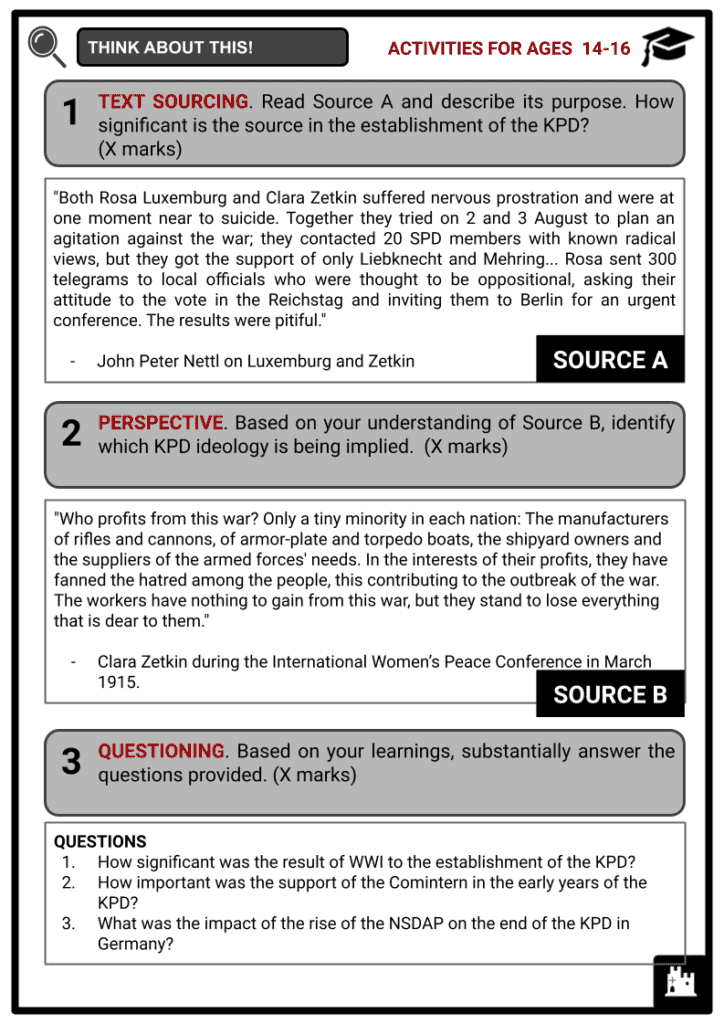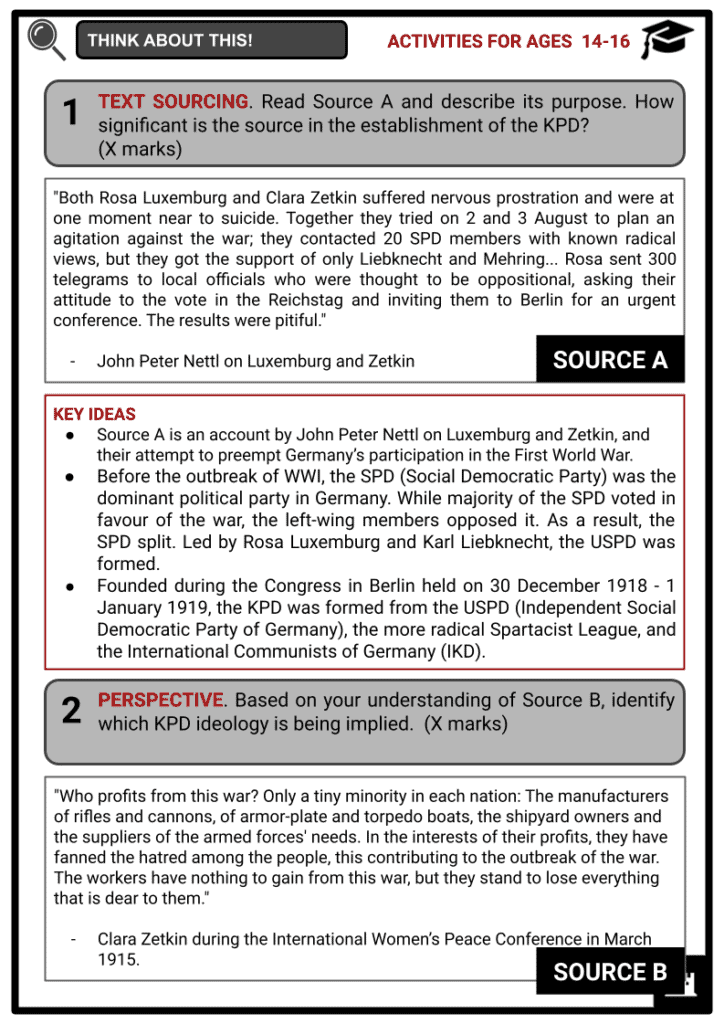Download The German Communist Party and the Weimar Republic Worksheets
Do you want to save dozens of hours in time? Get your evenings and weekends back? Be able to teach about the German Communist Party and the Weimar Republic to your students?
Our worksheet bundle includes a fact file and printable worksheets and student activities. Perfect for both the classroom and homeschooling!
Summary
- Origin, foundation and early years
- KPD during the Weimar Republic years
- Significant KPD leaders
Key Facts And Information
Let’s find out more about the German Communist Party and the Weimar Republic!
Founded after the First World War in 1918, the Communist Party of Germany, or Kommunistische Partei Deutschlands (KPD), was a political party that existed in the Weimar Republic (1918-1933). The party was highly inclined to Bolshevism and the establishment of a Soviet republic in Germany.

Amongst its prominent leaders were Rosa Luxemburg, Karl Liebknecht and Leo Jogiches. During the Weimar Republic, KPD seats in the Reichstag were usually polled between 10% to 15%. Since the emergence of Joseph Stalin as leader of the USSR, the KPD was largely controlled by the Comintern based in Moscow. KPD’s opponents included the SDP and NSDAP.
Following the elections in 1933, the KPD was banned by the ruling party: the NSDAP, or Nazi party. Until 1949, the KPD remained an underground organisation.
Origin, foundation and early years
- Founded during the Congress in Berlin held from 30 December 1918 to 1 January 1919, the KPD was formed from the USPD (Independent Social Democratic Party of Germany), the more radical Spartacist League, and the International Communists of Germany (IKD).
- Before the outbreak of WWI, the SPD (Social Democratic Party) was the dominant political party in Germany. While the majority of the SPD voted in favour of the war, the left-wing members opposed it. As a result, the SPD split. Led by Rosa Luxemburg and Karl Liebknecht, the USPD was formed.
- In November 1918, the German Revolution broke out. The USPD was joined by the Spartacist League and some members of the International Communists of Germany.
- The Spartacus League, or Spartakusbund, was a Marxist revolutionary movement founded by Luxemburg, Liebknecht and Clara Zetkin with the goal of launching an international proletarian revolution. The league opposed militarism, capitalism and imperialism.
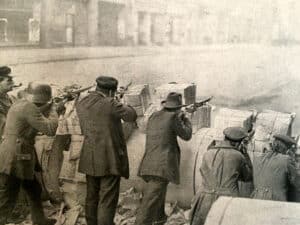
Spartacist Uprising in 1919 - After WWI, a democratic parliamentary republic was installed in replacement of the federal constitutional monarchy. Also known as the German Reich, the Weimar Republic lasted from 1918 until 1933.
- Friedrich Ebert, leader of the SPD, served as the first elected president of the Weimar Republic from 1919 until 1925.
- Since its establishment on 9 November 1918, the newly formed republic faced grave economic and political problems.
- Economically, the German people were burdened with paying reparations and dealing with hyperinflation.
- Political murders and paramilitary activities became common. Many Germans resented the government for accepting the Treaty of Versailles, which technically blamed the Germans for the consequences of WWI.
- The terms of the Treaty of Versailles only reached the public in May 1919. Many resented and regarded it as a ‘diktat’.
KPD during the Weimar Republic years
- In the 1920s, the KPD was the largest communist party in Europe outside the USSR. Following the victory of Joseph Stalin in the Soviet power struggle, Comintern leadership increased.
- In the 1919 general elections, the SPD dominated the new government with 163 seats out of 421. The USPD won 22 seats, while the KPD did not participate.
- The assassination of foreign minister Walther Rathenau merged the KPD and left-wing USPD members in June 1922. New members of the KPD included Paul Levi, Clara Zetkin, Ernst Toller, Walter Ulbricht, Ernst Thälmann, Ernst Meyer, Hermann Duncker, Hugo Eberlein and Julian Marchlewski.
- Following the expulsion of Levi from the party, Ernst Meyer was named as chairman of the KPD. From the original goal of an immediate revolution, the new KPD leadership shifted to contesting Reichstag elections.
- By 1924, KPD won 62 seats versus the SPD’s 100 seats.
- In 1925, Ernst Thälmann, a loyal supporter of Stalin, was elected as KPD leader. Under his leadership, KPD received direct funding from the Comintern. He established a united front that served the working class and fought right-wing militias.
- The KPD claimed that they were the only non-fascist party in the Weimar Republic. The party specifically called the SPD ‘social fascists’.
- From 2% votes during the federal election in 1920, KPD votes increased to 16.9% in the July 1932 elections, making them the party with the third-highest votes after the NSDAP and SPD.
- Under Thälmann’s leadership, the KPD fought the ruling SPD, which also gave way to the rise of Hitler, the NSDAP leader.
- In March 1932, Thälmann ran for president against the incumbent Paul von Hindenburg, and Adolf Hitler.
- During the Weimar Republic, about 30 political parties existed. Adopted from the French Assembly, ‘left wing’ and ‘right wing’ were used.
- Similar to NSDAP, the KPD appealed to the German working class. As a result, Hitler viewed the KPD as a political threat in 1933. In February 1933, following the appointment of Hitler as chancellor, the Reichstag fire was blamed on the Communists. As a result, KPD leaders were rounded up and sent to the Dachau concentration camp. After the passage of the Enabling Act in March 1933, some KPD members fled to the USSR, while SPD members voted against the act.
- In May 1933, KPD assets were confiscated. In 1934, Wilhelm Peck and Walter Ulbricht developed the Prague Manifesto, which aimed to save Germany. The KPD in Moscow founded the National Committee for a Free Germany. Similar organisations were created in the Netherlands and France.
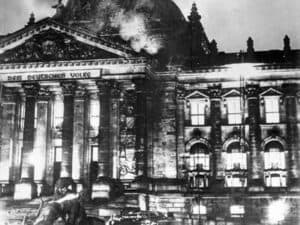
Reichstag fire - Following the Nazi-Soviet Pact in 1939, about 4,000 KPD refugees in the USSR were deported to Germany and sent to concentration camps.
- In the last years of the Weimar Republic, many KPD officials and members were deliberately murdered.
Significant KPD leaders
- Born in Poland, Rosa Luxemburg was a German revolutionary leader who founded the Polish Social Democratic Party and the Spartacus League. Luxemburg believed in Marxism and revolutionary action to achieve socialism. She urged the establishment of a proletarian government following the end of WWI. Under the influence of Bolshevism, Luxemburg established the German Communist Party with Liebknecht in December 1918.
- On 15 January 1919, Luxemburg and Liebknecht were arrested and murdered by the Freikorops in Berlin.
- Born in Leipzig, Germany, Karl Liebknecht was a Social Democrat who worked closely with Luxemburg in the foundation of the Spartacus League and the German Communist Party. As member of the SPD, he opposed the war, which caused his expulsion from the party. Instead of a national war, Liebknecht proposed a civil or class war. He published the pamphlet, The Main Enemy is at Home!
- Born in Hamburg, a part of the German Empire, Ernst Thälmann was the leader of the KPD from 1925 to 1933. In 1924, he established the Roter Frontkämpferbund, a far-left paramilitary organisation of the KPD, which was banned by the SPD in 1929. In 1932, he founded Antifaschistische Aktion, another militant anti-fascist organisation. The following year, he was arrested by the Gestapo and sent to solitary exile for 11 years. In 1944, he was shot under Hitler’s order.
- Between 1930 and 1933, Clara Zetkin represented the KPD in the Reichstag. Along with Paul Levi, Zetkin was one of the first communists to join the Reichstag. Aside from supporting Marxism, Zetkin was a known women’s rights activist. In 1921, she chaired the Second International Conference of Communist Women held in Moscow. In 1932, she became the oldest deputy in the Reichstag. In the same year, she received the Order of Lenin.

